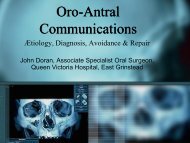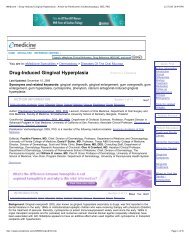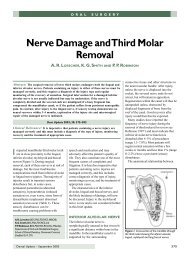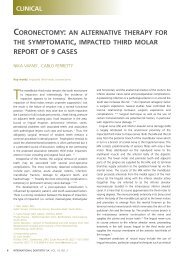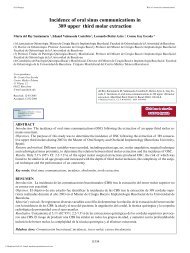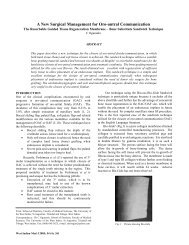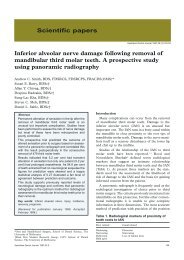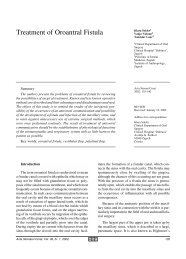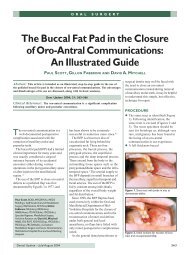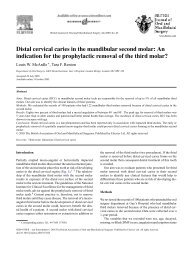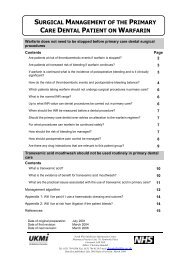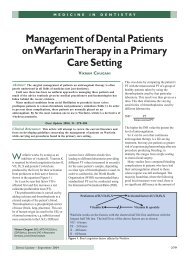Drug-Associated Gingival Enlargement
Drug-Associated Gingival Enlargement
Drug-Associated Gingival Enlargement
Create successful ePaper yourself
Turn your PDF publications into a flip-book with our unique Google optimized e-Paper software.
Academy Report<br />
Informational Paper<br />
<strong>Drug</strong>-<strong>Associated</strong> <strong>Gingival</strong> <strong>Enlargement</strong>*<br />
This informational paper is intended to provide the dental profession with an overview of existing evidence regarding<br />
the prevalence, risk factors, pathogenesis, and clinical management of drug-associated gingival enlargement.<br />
J Periodontol 2004;75:1424-1431.<br />
An increasing number of medications are associated<br />
with gingival enlargement. Currently, more<br />
than 20 prescription medications are associated<br />
with gingival enlargement, 1 and an estimated 5% of<br />
the elderly outpatient population in the United States<br />
is taking these medications. 2 “<strong>Gingival</strong> enlargement”<br />
or “gingival overgrowth” is the preferred term for all<br />
medication-related gingival lesions previously termed<br />
“gingival hyperplasia” or “gingival hypertrophy.” These<br />
earlier terms did not accurately reflect the histologic<br />
composition of the pharmacologically modified gingiva.<br />
<strong>Drug</strong>s associated with gingival enlargement can be<br />
broadly divided into three categories: anticonvulsants,<br />
calcium channel blockers, and immunosuppressants.<br />
Although the pharmacologic effect of each of these<br />
drugs is different and directed toward various primary<br />
target tissues, all of them seem to act similarly on a secondary<br />
target tissue, i.e., the gingival connective tissue,<br />
causing common clinical and histopathological findings.<br />
TYPES OF PHARMACOLOGIC AGENTS<br />
Anticonvulsants<br />
Phenytoin remains the drug of choice for treatment<br />
for grand mal, temporal lobe, and psychomotor<br />
seizures since it was first introduced in the 1930s. 3 In<br />
the U.S., about 2 million patients take phenytoin for<br />
seizure control. 4 The first reported cases of phenytoinassociated<br />
enlargement appeared more than 6 decades<br />
ago. 3 Since then, other anticonvulsant agents have<br />
been introduced that have frequently been linked to<br />
clinically significant forms of gingival enlargement. For<br />
example, gingival enlargement cases after chronic use<br />
of valproic acid, carbamazepine, or phenobarbitone in<br />
adult patients have been reported but are rare or have<br />
been poorly documented. 5-7 Vigabatrin is a relatively<br />
new antiepileptic agent that can cause gingival overgrowth.<br />
8 However, there has been no systematic<br />
attempt to study gingival enlargement in patients<br />
taking vigabatrin.<br />
* This paper was developed under the direction of the Research, Science<br />
and Therapy Committee and approved by the Executive Committee of<br />
the American Academy of Periodontology in July 2004.<br />
Calcium Channel Blockers<br />
Antihypertensive drugs in the calcium channel blocker<br />
group are used extensively in elderly patients who have<br />
angina or peripheral vascular disease. 3,9 The total number<br />
of annual prescriptions for this class of agents has<br />
continued to rise in recent years. 3 <strong>Gingival</strong> overgrowth<br />
associated with nifedipine was first reported in the early<br />
1980s and was soon also described with diltiazem, verapamil,<br />
and in rare cases with amlodipine and felodipine<br />
(reviewed in reference 3).<br />
Immunosuppressants<br />
Cyclosporin A (CsA) is a powerful immunosuppressant<br />
widely used for prevention of transplant rejection<br />
as well as for management of a number of<br />
autoimmune conditions such as rheumatoid arthritis.<br />
10,11 Successful use of CsA in transplant medicine<br />
has been limited by the development of prominent<br />
renal, cardiac, and gingival fibrosis. 12-15 Renal and<br />
cardiac lesions may be so severe as to cause transplant<br />
failure. 13-15 <strong>Gingival</strong> lesions were reported as<br />
soon as results of the first clinical trials of this medication<br />
were published, 16 and were more systematically<br />
examined in the 1980s.<br />
PREVALENCE<br />
Accurate determination of prevalence rates in each<br />
drug category is extremely difficult due to differences<br />
in the reported prevalence rates. These differences may<br />
be due, at least in part, to assessment of enlargement<br />
by medical versus dental personnel, differing indices of<br />
overgrowth, focus on institutionalized versus outpatient<br />
populations, type of systemic condition being treated,<br />
age of the patients, other medications administered<br />
simultaneously, poorly controlled underlying periodontal<br />
conditions, and other factors. Although the prevalence<br />
varies greatly in different reports, the gingival enlargement<br />
prevalence in phenytoin-treated, non-institutionalized<br />
patients is about 50%. 17<br />
<strong>Gingival</strong> enlargement in adult patients treated with<br />
valproic acid is rare. However, there have been a few<br />
reported cases in children. 3 Earlier studies found prevalence<br />
rates for nifedipine ranging between 15% and<br />
1424<br />
Volume 75 • Number 10
Academy Report<br />
Table 1.<br />
Estimated Prevalence of <strong>Drug</strong>-<strong>Associated</strong> <strong>Gingival</strong> <strong>Enlargement</strong><br />
According to the Most Frequently Reported Prevalence Rates<br />
Pharmacologic<br />
Category Agent Trade Name Prevalence<br />
Anticonvulsants Phenytoin Dilantin 50% 6,17,23<br />
Sodium valproate Depakene, Depacon, Rare 3,5,23<br />
(valproic acid) Epilim,Valpro<br />
Phenobarbitone Phenobarbital, Donnatal 70% 22<br />
Calcium channel Nifedipine Adalat, Nifecard, 6-15% 18-20<br />
blockers<br />
Procardia,Tenif<br />
Isradipine DynaCirc None reported<br />
Felodipine Agon, Felodur, Rare 3,20<br />
Lexxel, Plendil<br />
Amlodipine Lotrel, Norvasc Rare 3,20<br />
Verapamil Calan, Covera, Isoptin,
Academy Report<br />
Donor-host HLA mismatching was not correlated to the<br />
degree of gingival enlargement. 30<br />
Interactions between simultaneously administered<br />
medications affecting gingival enlargement have also<br />
been reported. Chronic comedication with phenytoin<br />
and other anticonvulsant agents does not affect the<br />
degree of gingival enlargement in adult epileptic<br />
patients. 37 However, CsA-treated patients are often on<br />
prednisolone or azathioprine as well, which can modify<br />
the severity of gingival enlargement. 38 In contrast,<br />
patients on CsA who are also receiving a calcium<br />
channel blocker present with a greater severity of the<br />
gingival lesions than patients medicated with CsA<br />
alone. 39 The choice of the calcium channel blocker<br />
used in conjunction with CsA can also affect the prevalence<br />
or severity of gingival enlargement. It has been<br />
reported that the prevalence of gingival overgrowth in<br />
renal transplant recipients maintained on CsA and<br />
amlodipine is higher than those receiving CsA and<br />
nifedipine. 40 In addition, when effects of a combined<br />
treatment of CsA and nifedipine or diltiazem were<br />
tested in an animal model, CsA was found to<br />
synergistically enhance gingival growth with nifedipine<br />
and to a lesser degree with diltiazem. 41<br />
CLINICAL MANIFESTATIONS OF GINGIVAL<br />
ENLARGEMENT<br />
Clinical manifestation of gingival enlargement frequently<br />
appears within 1 to 3 months after initiation of treatment<br />
with the associated medications. 42 <strong>Gingival</strong> overgrowth<br />
normally begins at the interdental papillae and<br />
is more frequently found in the anterior segment of the<br />
labial surfaces. 3,9 Gradually, gingival lobulations are<br />
formed that may appear inflamed or more fibrotic in<br />
nature, depending on the degree of local factor-induced<br />
inflammation. The fibrotic enlargement normally is confined<br />
to the attached gingiva but may extend coronally<br />
and interfere with esthetics, mastication, or speech. 3,9<br />
Disfiguring gingival overgrowth triggered by these<br />
medications is not only esthetically displeasing but often<br />
impairs nutrition and access for oral hygiene, resulting<br />
in an increased susceptibility to oral infection, caries,<br />
and periodontal diseases. 11<br />
Most drug-associated gingival enlargements appear<br />
to be clinically indistinguishable, with the possible exceptions<br />
of phenobarbitone 7 and CsA. 5 In phenobarbitonetreated<br />
patients, the gingiva may be enlarged uniformly<br />
without lobulations of the interdental papillae, and<br />
severity of the clinical lesions has been reported to be<br />
greater in the posterior as compared to the anterior<br />
regions. 7 In individuals immunosuppressed with CsA,<br />
sometimes pebbly or papillary lesions appear on the<br />
surface of larger lobulations, 43 which have been associated<br />
with the presence of Candida hyphae invading<br />
the gingival epithelium. 43,44 Other investigators have<br />
reported that tissues affected by CsA are generally<br />
more hyperemic and bleed more readily upon probing<br />
than tissues affected by phenytoin. 5<br />
HISTOPATHOLOGY OF THE LESION<br />
An ultrastructural study demonstrated that the increase<br />
in gingival tissue volume is primarily due to a connective<br />
tissue response rather than epithelial cell layer<br />
involvement. 45 The histopathology of the lesions in all<br />
drug categories is similar and is characterized by excessive<br />
accumulation of extracellular matrix proteins, such<br />
as collagen, or amorphous ground substance. 3,4,9<br />
Varying degrees of inflammatory infiltrate exist, while<br />
an increase in the number of fibroblasts remains controversial.<br />
46-48 The predominant type of infiltrating<br />
inflammatory cell is the plasma cell. Parakeratinized<br />
epithelium of variable thickness covers the connective<br />
tissue stroma, and epithelial ridges may penetrate deep<br />
into the connective tissue, creating irregularly arranged<br />
collagen fibers. 45<br />
PATHOGENESIS<br />
Role of Fibroblasts<br />
The mechanism through which these medications trigger<br />
a connective tissue response in the gingiva is still<br />
poorly understood. Because only a subset of patients<br />
treated with these medications will develop gingival<br />
overgrowth, it has been hypothesized that these individuals<br />
have fibroblasts with an abnormal susceptibility<br />
to the drug. Indeed, it has been shown that fibroblasts<br />
from overgrown gingiva in phenytoin-treated patients<br />
are characterized by elevated levels of protein synthesis,<br />
most of which is collagen. 49 However, results<br />
of a study comparing intraoral lesions with the presence<br />
of fibrosis at extraoral sites failed to show that<br />
the severity of gingival enlargement correlates well<br />
with the formation of fibrotic lesions elsewhere in the<br />
body. 50 Such enlargement cannot be considered a<br />
consequence of systemic and/or genetic fibroblast<br />
hyperactivity. A limitation of this study was that the<br />
conclusions were based on examination of extraoral<br />
tissues at the macroscopic level only. 50<br />
It also has been proposed that susceptibility or resistance<br />
to pharmacologically induced gingival enlargement<br />
may be governed by the existence of differential<br />
proportions of fibroblast subsets in each individual<br />
which exhibit a fibrogenic response to these medications.<br />
49,51 In support of this hypothesis, it has been<br />
shown that functional heterogeneity exists in gingival<br />
1426 Informational Paper<br />
Volume 75 • Number 10
Academy Report<br />
fibroblasts in response to various stimuli. 49,52 It was<br />
further demonstrated that CsA could react with a phenotypically<br />
distinct subpopulation of gingival fibroblasts<br />
to enhance protein synthesis. 53,54<br />
Role of Inflammatory Cytokines<br />
A synergistic enhancement of collagenous protein synthesis<br />
by human gingival fibroblasts was found when<br />
these cells were simultaneously exposed to nifedipine<br />
and interleukin-1β (IL-1β), a proinflammatory cytokine<br />
that is elevated in inflamed gingival tissues. 55 In addition<br />
to IL-1β, IL-6 may play a role in the fibrogenic<br />
responses of the gingiva to these medications. 56 A<br />
reported histologic feature of CsA-induced gingival<br />
lesions is a dramatic elevation in the expression of<br />
IL-6 by cells within the gingival connective tissue. 56<br />
IL-6 appears to target connective tissue cells such as<br />
fibroblasts both by enhancing proliferation 57 and by<br />
exerting a positive regulation on collagen and glycosaminoglycan<br />
synthesis. 58 Therefore, this cytokine<br />
has been proposed to play a pathogenic role in fibrotic<br />
diseases such as pulmonary and gingival fibroses. 7,51<br />
Fibroblasts derived from CsA-influenced overgrown<br />
gingiva “spontaneously” secreted higher IL-6 levels<br />
than from inflamed or normal gingiva in vitro. 59 In<br />
addition, CsA, nifedipine, and phenytoin were found to<br />
synergize with IL-1β to further enhance secretion of<br />
this cytokine by gingival fibroblasts in vitro. 51<br />
Role of Matrix Metalloproteinase (MMP) Synthesis<br />
and Function<br />
Because most types of pharmacological agents implicated<br />
in gingival enlargement have negative effects on<br />
calcium ion influx across cell membranes, it was postulated<br />
that such agents may interfere with the synthesis<br />
and function of collagenases. 60 In support of this<br />
hypothesis, a recent in vitro study has shown that<br />
human gingival fibroblasts treated with clinically relevant<br />
CsA doses exhibit significantly reduced levels of<br />
MMP-1 and MMP-3 secretion; these reduced levels<br />
may contribute to the accumulation of extracellular<br />
matrix components. 61 These findings were further supported<br />
by an animal study that showed lower collagenase<br />
mRNA levels in situ accompanied by a<br />
decrease in collagen phagocytosis and degradation. 62<br />
PREVENTION AND TREATMENT OF GINGIVAL<br />
ENLARGEMENT<br />
Prevention<br />
In the susceptible patient, drug-associated gingival<br />
enlargement may be ameliorated, but not prevented,<br />
by elimination of local factors, meticulous plaque control,<br />
and regular periodontal maintenance therapy. A<br />
3-month interval for periodontal maintenance therapy<br />
has been recommended for patients taking drugs associated<br />
with gingival enlargement. 63 Each recall appointment<br />
should include detailed oral hygiene instructions<br />
and complete periodontal prophylaxis, with supra- and<br />
subgingival calculus removal as needed. In pediatric<br />
patients, it is recommended that parents also receive<br />
oral hygiene instructions. In some instances, orthodontic<br />
bands and/or appliances should be removed. 64 An<br />
animal study has shown that topically applied 0.12%<br />
chlorhexidine can reduce the severity of gingival<br />
enlargement triggered by CsA administration 65 and<br />
thus may be a valuable tool in the prevention and overall<br />
management of gingival enlargement in humans.<br />
Treatment<br />
<strong>Drug</strong> substitution/withdrawal. The most effective<br />
treatment of drug-related gingival enlargement is withdrawal<br />
or substitution of medication. When this treatment<br />
approach is taken, as suggested by a case report,<br />
it may take from 1 to 8 weeks for resolution of gingival<br />
lesions. 43 Unfortunately, not all patients respond to<br />
this mode of treatment, especially those with longstanding<br />
gingival lesions. 3<br />
Substitution of phenytoin with a different anticonvulsant<br />
has long been suggested as the treatment of<br />
choice for the severely affected gingiva. Recently, the<br />
feasibility of phenytoin substitution has increased with<br />
the addition of a new generation of anticonvulsants<br />
such as lomatrigine, gabapentin, sulthiame, and topiramate.<br />
Changes from nifedipine to diltiazem or verapamil<br />
by the patient’s physician are an option.<br />
Changing hypertensive therapy from nifedipine to an<br />
antihypertensive of the same class, such as isradipine,<br />
may result in regression of gingival enlargement. 66<br />
Tacrolimus (FK506) is an alternative immunosuppressant<br />
for renal transplant recipients that has not<br />
been associated with gingival enlargement. Switching<br />
from CsA to tacrolimus can cause significant resolution<br />
or complete regression of the gingival enlargement<br />
in renal transplant recipients. 67 However, in heart<br />
transplant patients, if the patient is medically stable and<br />
side effects of immunosuppression with CsA are well<br />
controlled, the cardiology team will frequently be disinclined<br />
to alter the therapeutic regimen. 43<br />
Non-surgical treatment. Professional debridement<br />
with scaling and root planing as needed has been<br />
shown to offer some relief in gingival overgrowth<br />
patients. 68 In chronically immunosuppressed patients,<br />
papillary lesions present on the surface of the enlarged<br />
gingiva have been reported to resolve using topical<br />
J Periodontol • October 2004<br />
<strong>Drug</strong>-<strong>Associated</strong> <strong>Gingival</strong> <strong>Enlargement</strong> 1427
Academy Report<br />
antifungal medications (e.g., nystatin lozenges). 43,44<br />
Slight to moderate gingival enlargement following CsA<br />
treatment has also been treated with a short course of<br />
azithromycin (3 to 5 days, 250 to 500 mg/day), 69,70<br />
a semisynthetic macrolide derived from erythromycin<br />
that does not affect cyclosporin blood levels. 70 Findings<br />
from several case reports, two non-randomized<br />
prospective clinical trials, and one randomized double-blind<br />
cross-over trial in CsA-treated renal transplant<br />
recipients suggest that if gingival overgrowth is<br />
treated early with azithromycin, amelioration or complete<br />
regression of the lesions is possible (reviewed in<br />
reference 70). The overall duration of the effects of<br />
azithromycin ranges between 3 months and 2 years. 70<br />
Another study contradicts these findings, showing that<br />
a 7-day course of azithromycin (or metronidazole) does<br />
not induce remission of CsA-induced gingival overgrowth,<br />
although it acts on concomitant bacterial overinfection<br />
and gingival inflammation. 71<br />
Surgical periodontal treatment. Because the anterior<br />
labial gingiva is frequently involved, surgery is<br />
commonly performed for esthetic reasons before any<br />
functional consequences are present. The classical surgical<br />
approach has been the external bevel gingivectomy.<br />
However, a total or partial internal gingivectomy<br />
approach has been suggested as an alternative. 3 This<br />
more technically demanding approach has the benefit<br />
of limiting the large denuded connective tissue wound<br />
that results from the external gingivectomy, thereby<br />
minimizing postoperative pain and bleeding.<br />
The use of carbon dioxide lasers has shown some<br />
utility for reducing gingival enlargement, an approach<br />
which provides rapid postoperative hemostasis.<br />
Consultation with the patient’s physician prior to surgical<br />
treatment regarding antibiotic and steroid coverage<br />
should take place in the immunosuppressed<br />
patient. 3 Another eminent complication is primary<br />
high blood pressure or high blood pressure secondary<br />
to CsA treatment. If blood pressure is poorly controlled,<br />
surgical reduction of the overgrown gingiva<br />
should be postponed because of the risk of postoperative<br />
hemorrhage. Sudden unnecessary changes in<br />
dental chair position should also be avoided to prevent<br />
postural hypotension. 43<br />
Treatment outcomes and recurrence rate. The recurrence<br />
rate of severe gingival enlargement in CsA- or<br />
nifedipine-treated patients after surgical periodontal therapy<br />
was found to be about 40% within 18 months after<br />
active treatment. 72 Significant determinants of recurrence<br />
were found to be younger age, gingival inflammation,<br />
and poor compliance with maintenance visits. 72<br />
Chlorhexidine (0.12%) oral rinse twice daily has been<br />
reported to prevent recurring overgrowth following surgical<br />
treatment. 23<br />
MOLECULAR BIOLOGY: POTENTIAL<br />
SOLUTIONS TO AN AGE-OLD PROBLEM<br />
Clearly, our understanding of the pathogenesis of gingival<br />
overgrowth is incomplete at best; however, the<br />
development of novel preventative and therapeutic<br />
approaches to gingival overgrowth requires a systematic<br />
approach. This should include the development<br />
and use of animal models of gingival overgrowth 24,25<br />
and organotypic- 26,73 and single-cell culture systems, 74<br />
which can be cross-correlated with human gingival<br />
tissue studies. 75,76 The complexity of the events that<br />
contribute to gingival overgrowth have yet to be fully<br />
realized, but will require molecular and high throughput<br />
approaches, such as reverse transcription-polymerase<br />
chain reaction (RT-PCR), quantitative real-time PCR,<br />
and DNA microarray technologies. 75,76<br />
CONCLUSION<br />
The use of medications with the potential to contribute<br />
to the development of gingival overgrowth will likely<br />
increase in the years to come. Among the old and<br />
relatively newer pharmacologic agents involved in gingival<br />
enlargement, overall, phenytoin still has the highest<br />
prevalence rate (approximately 50%), with calcium<br />
channel blockers and CsA-associated enlargements<br />
about half as prevalent. Current studies on the pathogenetic<br />
mechanism of drug-associated enlargement<br />
are focusing on the direct and indirect effects of these<br />
drugs on gingival fibroblast metabolism. If possible,<br />
treatment is generally targeted on drug substitution<br />
and effective control of local inflammatory factors<br />
such as plaque and calculus. When these measures<br />
fail to cause resolution of the enlargement, surgical<br />
intervention is recommended. These treatment modalities,<br />
although effective, do not necessarily prevent<br />
recurrence of the lesions. Newer molecular approaches<br />
are needed to clearly establish the pathogenesis of<br />
gingival overgrowth and to provide novel information<br />
for the design of future preventative and therapeutic<br />
modalities.<br />
ACKNOWLEDGMENTS<br />
The primary author for this paper is Dr. Anna Dongari-<br />
Bagtzoglou. The editorial assistance of Dr. Christopher<br />
Cutler is gratefully acknowledged. Members of<br />
the 2003-2004 Research, Science and Therapy Committee<br />
include: Drs. Henry Greenwell, Chair; Joseph<br />
Fiorellini, William Giannobile, Steven Offenbacher,<br />
Leslie Salkin; Cheryl Townsend, Board Liaison; Phillip<br />
1428 Informational Paper<br />
Volume 75 • Number 10
Academy Report<br />
Sheridan, Board Consultant; Robert J. Genco, Ex-<br />
Officio.<br />
REFERENCES<br />
1. Rees TD, Levine RA. Systemic drugs as a risk factor<br />
for periodontal disease initiation and progression. Compend<br />
Contin Educ Dent 1995;16:20-42.<br />
2. Lewis IK, Hanlon JT, Schmader KE, et al. Use of medications<br />
with potential oral adverse drug interactions in community-dwelling<br />
elderly. Spec Care Dentist 1993;13:<br />
171-176.<br />
3. Marshall RI, Bartold PM. A clinical review of drug-induced<br />
gingival overgrowth. Aust Dent J 1999;44:219-232.<br />
4. Dongari AI, Langlais RP, McDonnell HT. <strong>Drug</strong>-induced<br />
gingival overgrowth. Oral Surg Oral Med Oral Pathol<br />
1993;76:543-548.<br />
5. Seymour R, Heasman P. <strong>Drug</strong>s, Diseases and the Periodontium.<br />
Oxford: Oxford University Press; 1992.<br />
6. Dahlof G, Preber H, Eliasson S, et al. Periodontal condition<br />
of epileptic adults treated long-term with phenytoin<br />
or carbamazepine. Epilepsia 1993;34:960-964.<br />
7. Gregoriou A, Schneider P, Shaw P. Phenobarbital-induced<br />
gingival overgrowth Report of two cases and complications<br />
in management. ASDC J Dent Child 1996;63:<br />
408-413.<br />
8. Katz J, Givol N, Chaushu G, Taicher S, Shemer J. Vigabatrin-induced<br />
gingival overgrowth. J Clin Periodontol<br />
1997;24:180-182.<br />
9. Hallmon WW, Rossmann JA. The role of drugs in the<br />
pathogenesis of gingival overgrowth. A collective review<br />
of current concepts. Periodontol 2000 1999;21:176-196.<br />
10. Proceedings of the Second International Congress on<br />
Cyclosporine. Washington, DC: Grune and Stratton;<br />
1988:1-25.<br />
11. Hassell TM, Hefti AF. <strong>Drug</strong>-induced gingival overgrowth:<br />
Old problem, new problem. Crit Rev Oral Biol<br />
Med 1991;2:103-137.<br />
12. Rateitschak-Pluss E, Hefti A, Lortscher R, Thiel G. Initial<br />
observation that cyclosporin-A induces gingival enlargement<br />
in man. J Clin Periodontol 1983;10:237-246.<br />
13. Myers BD, Newton L. Cyclosporine-induced chronic<br />
nephropathy: An obliterative microvascular renal injury.<br />
J Am Soc Nephrol 1991 Aug;2(2 Suppl. 1):S45-S52.<br />
14. Platt JL, Ferguson RM, Sibley RK, Gajl-Peczalska KJ,<br />
Michael AF. Renal interstitial cell populations in cyclosporine<br />
nephrotoxicity: Identification using monoclonal<br />
antibodies. Transplantation 1983;36:343-346.<br />
15. Billingham ME. Diagnosis of acute cardiac rejection by<br />
endomyocardial biopsy. Bibl Cardiol 1988;43:83-102.<br />
16. Calne RY, Thiru S, McMaster P, et al. Cyclosporine A<br />
in patients receiving renal allografts from cadaver<br />
donors. Lancet 1978;2:1323-1327.<br />
17. Casetta I, Granieri E, Desidera M, et al. Phenytoin-induced<br />
gingival overgrowth: A community-based cross-sectional<br />
study in Ferrara, Italy. Neuroepidemiology 1997;16:296-<br />
303.<br />
18. Barak S, Engelberg I, Hiss Z. <strong>Gingival</strong> hyperplasia<br />
caused by nifedipine: Histopathological findings. J Periodontol<br />
1987;58:639-642.<br />
19. Fattore L, Stablein M, Bredfelt G, et al. <strong>Gingival</strong> hyperplasia:<br />
A side effect of nifedipine and diltiazem. Spec<br />
Care Dent 1991;11:107-109.<br />
20. Ellis JS, Seymour RA, Steele JG, Robertson P, Butler<br />
TJ, Thomason JM. Prevalence of gingival overgrowth<br />
induced by calcium channel blockers: A communitybased<br />
study. J Periodontol 1999;70:63-67.<br />
21. Boltchi FE, Rees TD, Iacopino AM. Cyclosporine A-<br />
induced gingival overgrowth: A comprehensive review.<br />
Quintessence Int 1999;30:775-783.<br />
22. Kilpatrick NM, Weintraub RG, Lucas JO, Shipp A,<br />
Byrt T, Wilkinson JL. <strong>Gingival</strong> overgrowth in pediatric<br />
heart and heart-lung transplant recipients. J Heart Lung<br />
Transplant 1997;16:1231-1237.<br />
23. Ciancio S, Bartz N, Lauciello F. Cyclosporine-induced<br />
gingival hyperplasia and chlorhexidine: A case report.<br />
Int J Periodontics Restorative Dent 1991;11:241-245.<br />
24. Fu E, Nieh S, Hsiao CT, Hsieh YD, Wikesjö UM, Shen<br />
EC. Nifedipine-induced gingival overgrowth in rats: Brief<br />
review and experimental study. J Periodontol 1998;69:<br />
765-771.<br />
25. Meller AT, Rumjanek VM, Sansone C, Allodi S. Oral<br />
mucosa alterations induced by cyclosporin in mice:<br />
Morphological features. J Periodontal Res 2002;37:<br />
412-415.<br />
26. Andriani F, Margulis A, Lin N, Griffey S, Garlick JA.<br />
Analysis of microenvironmental factors contributing to<br />
basement membrane assembly and normalized epidermal<br />
phenotype. J Invest Dermatol 2003;120:923-931.<br />
27. Nakou M, Kamma JJ, Andronikaki A, Mitsis F. Subgingival<br />
microflora associated with nifedipine-induced<br />
gingival overgrowth. J Periodontol 1998;69:664-669.<br />
28. Armitage GC. Development of a classification system<br />
for periodontal diseases and conditions. Ann Periodontol<br />
1999;4:1-6.<br />
29. Fu E, Nieh S, Wikesjö UM. The effect of plaque retention<br />
on cyclosporine-induced gingival overgrowth in<br />
rats. J Periodontol 1997;68:92-98.<br />
30. Thomas DW, Newcombe RG, Osborne GR. Risk factors<br />
in the development of cyclosporine-induced gingival<br />
overgrowth. Transplantation 2000;69:522-526.<br />
31. Varga E, Lennon MA, Mair LH. Pre-transplant gingival<br />
hyperplasia predicts severe cyclosporin-induced gingival<br />
overgrowth in renal transplant patients. J Clin<br />
Periodontol 1998;25:225-230.<br />
32. Thomason J, Kelly P, Seymour R. The distribution of<br />
gingival overgrowth in organ transplant patients. J Clin<br />
Periodontol 1996;23:367-371.<br />
33. Penarrocha-Diago M, Bagan-Sebastian J, Vera-Sempere<br />
F. Diphenylhydantoin-induced gingival overgrowth<br />
in man: A clinico-pathological study. J Periodontol<br />
1990;61:571-574.<br />
34. Nery E, Edson R, Lee K, et al. Prevalence of nifedipineinduced<br />
gingival hyperplasia. J Periodontol 1995;66:<br />
572-578.<br />
35. Thomason J, Seymour R, Ellis J, et al. Determinants<br />
of gingival overgrowth severity in organ transplant<br />
recipients: An examination of the role of the HLA phenotype.<br />
J Clin Periodontol 1996;23:628-634.<br />
36. Cebeci I, Kantarci A, Firatli E, et al. Evaluation of the<br />
frequency of HLA determinants in patients with gingival<br />
overgrowth induced by cyclosporine A. J Clin Periodontol<br />
1996;23:737-742.<br />
37. Kamali F, McLaughlin WS, Ball DE, Seymour RA. The<br />
effect of multiple anticonvulsant therapy on the expres-<br />
J Periodontol • October 2004<br />
<strong>Drug</strong>-<strong>Associated</strong> <strong>Gingival</strong> <strong>Enlargement</strong> 1429
Academy Report<br />
sion of phenytoin-induced gingival overgrowth. J Clin<br />
Periodontol 1999;26:802-805.<br />
38. Wilson RF, Morel A, Smith D, et al. Contribution of<br />
individual drugs to gingival overgrowth in adult and<br />
juvenile renal transplant patients treated with multiple<br />
therapy. J Clin Periodontol 1998;25:457-464.<br />
39. Thomason JM, Ellis JS, Kelly PJ, Seymour RA. Nifedipine<br />
pharmacological variables as risk factors for gingival<br />
overgrowth in organ-transplant patients. Clin Oral<br />
Invest 1997;1:35-39.<br />
40. James JA, Marley JJ, Jamal S, et al. The calcium<br />
channel blocker used with cyclosporin has an effect<br />
on gingival overgrowth. J Clin Periodontol 2000;27:109-<br />
115.<br />
41. Morisaki I, Fukui N, Fujimori Y, Murakami J, Daikoku H,<br />
Amano A. Effects of combined oral treatments with<br />
cyclosporine A and nifedipine or diltiazem on druginduced<br />
gingival overgrowth in rats. J Periodontol 2000;<br />
71:438-443.<br />
42. Meraw SJ, Sheridan PJ. Medically induced gingival<br />
hyperplasia. Mayo Clin Proc 1998;73:1196-1199.<br />
43. Khocht A, Schneider LC. Periodontal management of<br />
gingival overgrowth in the heart transplant patient: A<br />
case report. J Periodontol 1997;68:1140-1146.<br />
44. Payne VM. Re: Periodontal management of gingival overgrowth<br />
in the heart transplant patient: A case report<br />
(1997;68:1140-1146). J Periodontol 1998;69:1314-1315.<br />
45. Mariani G, Calastrini C, Carinci F, et al. Ultrastructural<br />
features of CsA-induced gingival hyperplasia. J Periodontol<br />
1993;64:1092-1097.<br />
46. Wysocki GP, Gretzinger HA, Laupacis A, Ulan RA,<br />
Stiller CR. Fibrous hyperplasia of the gingiva: A side<br />
effect of cyclosporin-A therapy. Oral Surg Oral Med<br />
Oral Pathol 1983;55:274-278.<br />
47. Rostock MH, Fryt HR, Turner JE. Severe gingival overgrowth<br />
associated with cyclosporine therapy. J Periodontol<br />
1986;57:294-299.<br />
48. Santi E, Bral M. Effect of treatment on cyclosporineand<br />
nifedipine-induced gingival enlargement: Clinical<br />
and histologic results. Int J Periodontics Restorative<br />
Dent 1998;18:80-85.<br />
49. Hassell TM, Page RC, Narayanan AS, Cooper CG.<br />
Diphenylhydantoin (Dilantin) gingival hyperplasia:<br />
<strong>Drug</strong>-induced abnormality of connective tissue. Proc<br />
Natl Acad Sci (USA) 1976;73:2909-2912.<br />
50. Montebugnoli L, Bernardi F. Cyclosporin A effects on<br />
extraoral connective tissue in heart transplanted<br />
patients. J Int Acad Periodontol 1999;1:91-94.<br />
51. Sinha-Morton R, Dongari-Bagtzoglou AI. Regulation<br />
of gingival fibroblast interleukin-6 secretion by<br />
cyclosporine A. J Periodontol 1999;70:1464-1471.<br />
52. Dongari-Bagtzoglou A, Ebersole JL. Increased presence<br />
of interleukin-6 (IL-6) and IL-8 secreting fibroblast subpopulations<br />
in adult periodontitis. J Periodontol 1998;<br />
69:899-910.<br />
53. Hassell TM, Buchanan J, Cuchens M, et al. Fluorescence<br />
activated vital cell sorting of human fibroblast<br />
subpopulations that bind CsA. J Dent Res 1988;67:273-<br />
276.<br />
54. Mariotti A, Hassell T, Jacobs D, Manning CJ, Hefti AF.<br />
Cyclosporin A and hydroxycyclosporine (M-17) affect<br />
the secretory phenotype of human gingival fibroblasts.<br />
J Oral Pathol Med 1998;27:260-266.<br />
55. Johnson RB, Zebrowski EJ, Dai X. Synergistic enhancement<br />
of collagenous protein synthesis by human<br />
gingival fibroblasts exposed to nifedipine and interleukin-1-beta<br />
in vitro. J Oral Pathol Med 2000;29:8-12.<br />
56. Williamson MS, Miller EK, Plemons J, Rees T, Iacopino<br />
AM. Cyclosporine A upregulates interleukin-6<br />
gene expression in human gingiva: Possible mechanism<br />
for gingival overgrowth. J Periodontol 1994;65:895-<br />
903.<br />
57. Fries KM, Felch M, Phipps R. Interleukin-6 is an<br />
autocrine growth factor for murine lung fibroblast subsets.<br />
Am J Respir Cell Mol Biol 1994;11:552-560.<br />
58. Duncan MR, Berman B. Stimulation of collagen and<br />
glycosaminoglycan production in cultured human adult<br />
dermal fibroblasts by recombinant human interleukin-<br />
6. J Invest Dermatol 1991;97:686-689.<br />
59. Myrillas TT, Linden GJ, Marley JJ, Irwin CR. Cyclosporin<br />
A regulates interleukin-1beta and interleukin-6<br />
expression in gingiva: Implications for gingival overgrowth.<br />
J Periodontol 1999;70:294-300.<br />
60. Hassell TM. Evidence for production of an inactive collagenase<br />
by fibroblasts from phenytoin-enlarged human<br />
gingiva. J Oral Pathol 1982;11:310-317.<br />
61. Bolzani G, Della Coletta R, Martelli Junior H, Martelli<br />
Junior H, Graner E. Cyclosporin A inhibits production<br />
and activity of matrix metalloproteinases by gingival<br />
fibroblasts. J Periodontal Res 2000;35:51-58.<br />
62. Kataoka M, Shimizu Y, Kunikiyo K, et al. Cyclosporin A<br />
decreases the degradation of type I collagen in rat gingival<br />
overgrowth. J Cell Physiol 2000;182:351-358.<br />
63. Hall EE. Prevention and treatment considerations in<br />
patients with drug-induced gingival enlargement. Curr<br />
Opin Periodontol 1997;4:59-63.<br />
64. Boraz RA. A dental protocol for the pediatric cardiac<br />
transplant patient. ASDC J Dent Child 1986;53:382-<br />
385.<br />
65. Pilatti GL, Sampaio JE. The influence of chlorhexidine<br />
on the severity of cyclosporin A-induced gingival overgrowth.<br />
J Periodontol 1997;68:900-904. Erratum in: J<br />
Periodontol 1998;69:102.<br />
66. Westbrook P, Bednarczyk EM, Carlson M, Sheehan H,<br />
Bissada NF. Regression of nifedipine-induced gingival<br />
hyperplasia following switch to a same class calcium<br />
channel blocker, isradipine. J Periodontol 1997;68:645-<br />
650.<br />
67. James JA, Boomer S, Maxwell AP, et al. Reduction in<br />
gingival overgrowth associated with conversion from<br />
cyclosporin A to tacrolimus. J Clin Periodontol 2000;27:<br />
144-148.<br />
68. Somacarrera ML, Lucas M, Scully C, Barrios C. Effectiveness<br />
of periodontal treatments on cyclosporineinduced<br />
gingival overgrowth in transplant patients. Br<br />
Dent J 1997;183:89-94.<br />
69. Gomez E, Sanchez-Nunez M, Sanchez JE, et al. Treatment<br />
of cyclosporin-induced gingival hyperplasia with<br />
azithromycin. Nephrol Dial Transplant 1997;12:2694-<br />
2697.<br />
70. Strachan D, Burton I, Pearson GJ. Is oral azithromycin<br />
effective for the treatment of cyclosporine-induced<br />
gingival hyperplasia in cardiac transplant recipients J<br />
Clin Pharm Ther 2003;28:329-338.<br />
1430 Informational Paper<br />
Volume 75 • Number 10
Academy Report<br />
71. Mesa FL, Osuna A, Aneiros J, et al. Antibiotic treatment<br />
of incipient drug-induced gingival overgrowth in<br />
adult renal transplant patients. J Periodontal Res 2003;<br />
38:141-146.<br />
72. Ilgenli T, Atilla G, Baylas H. Effectiveness of periodontal<br />
therapy in patients with drug-induced gingival overgrowth.<br />
Long-term results. J Periodontol 1999;70:967-<br />
972.<br />
73. Hildebrand HC, Hakkinen L, Wiebe CB, Larjava HS.<br />
Characterization of organotypic keratinocyte cultures<br />
on de-epithelialized bovine tongue mucosa. Histol<br />
Histopathol 2002;17:151-163.<br />
74. Cotrim P, Martelli-Junior H, Graner E, Sauk JJ, Coletta<br />
RD. Cyclosporin A induces proliferation in human gingival<br />
fibroblasts via induction of transforming growth<br />
factor-beta1. J Periodontol 2003;74:1625-1633.<br />
75. Gnoatto N, Lotufo RF, Toffoletto O, Marquezini MV.<br />
Gene expression of extracellular matrix proteoglycans<br />
in human cyclosporin-induced gingival overgrowth.<br />
J Periodontol 2003;74:1747-1753.<br />
76. Bolcato-Bellemin AL, Elkaim R, Tenenbaum H.<br />
Expression of RNAs encoding for alpha and beta integrin<br />
subunits in periodontitis and in cyclosporin A gingival<br />
overgrowth. J Clin Periodontol 2003;30:937-943.<br />
Individual copies of this paper may be obtained on the<br />
Academy’s Web site at http://www.perio.org. Members of<br />
the American Academy of Periodontology have permission<br />
of the Academy, as copyright holder, to reproduce up to<br />
150 copies of this document for not-for-profit, educational<br />
purposes only. For information on reproduction of the document<br />
for any other use or distribution, please contact Rita<br />
Shafer at the Academy Central Office; voice: 312/573-<br />
3221; fax: 312/573-3225; e-mail: rita@perio.org.<br />
J Periodontol • October 2004<br />
<strong>Drug</strong>-<strong>Associated</strong> <strong>Gingival</strong> <strong>Enlargement</strong> 1431



